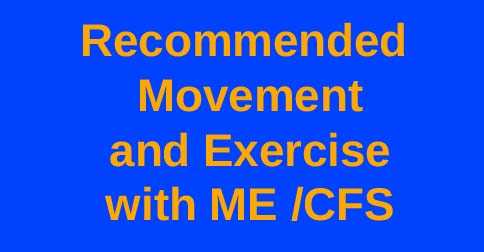Recommended Movement and Exercise with ME / CFS

The first target a CFS / ME sufferer should be aiming for is the minimal movement needed for health. Don't make yourself ill trying to achieve this goal: it's important to listen to your body. Equally, it's important to try to do at least the minimal level for your recovery. After you achieve this minimum, you might even consider more.
The modern minimum has been best defined by Joan Vernikos in her book Sitting Kills: Moving Heals (an unfortunate, hyperbolic title that can be upsetting, I know). Joan worked for Nasa rehabilitating astronauts on their return from space. What she found was that the notion of spending an hour exercising in the gym per day for health and fitness was misguided. Instead what Joan found was that all day simple movement was best for recovery and health.
To simulate space conditions Joan had volunteers that would stay in bed for weeks not moving so they would have the same kind of muscle atrophy as astronauts. This is of course similar to the experience of many with CFS / ME to varying degrees.
Then, measuring scientifically, her team discovered that the best method for the recovery of health was all day movement.
For example, at an absolute minimum Joan recommends getting up and standing for 2 minutes 32 times throughout the day (the getting up and sitting back down parts are important). Even having a bed that stands the patient up for two minutes seemed to produce good results.
As we can see, this might be too much for some CFS / ME patients; they may need to take it slowly, but even a bed that stands them may help (so long as it isn't putting excessive pressure on the heart, some with ME / CFS suffer light-headedness on standing). For others, this may be achievable. They may even want to look to add more all day movement to their routine.
Katy Bowman, a biomechanical scientist, has been influenced by the work of Joan Vernikos and also recommends all day movement for health. She's also interested in health through movement related to alignment, internal organs (helping with acid reflux, for example), blood and lymph circulation and bone health.
Bowman compares movement to diet and splits movements into macro nutrients and micro nutrients: All of which are required for a healthy movement diet.
Micro nutrients are smaller movements for strengthening stabiliser muscles, improving the mobility of joints, and correcting posture / alignment (poor posture may also be putting pressure on internal organs, for example). They are generally gentle physiotherapy stretches geared at undoing the damage caused by modern living (damage cause by sitting too much, for example).
Macro nutrients are walking, hanging, carrying and the bodyweight squat (which might take some work to achieve).
Dr. Sarah Myhill has also written on movement for CFS / ME sufferers and I recommend you check out this page too.
For more, see the following resources
- Sitting Kills: Moving Heals, a short book by Joan Vernikos
- Born to Move: A Body in Motion Stays Healthy Longer, a lecture by Joan Vernikos
- Move Your DNA: Restore Your Health Through Natural Movement, a book by Katy Bowman
- Move your Cells, an interview with Katy Bowman
- Movement Multivitamin DVD, Katy Bowman's instructional video on "micro nutrient" stretches
- Where to start with movement culture, a blog post for the more advanced to consider